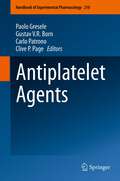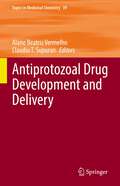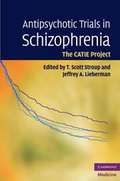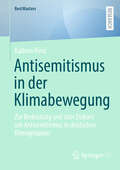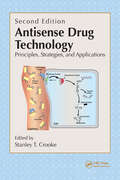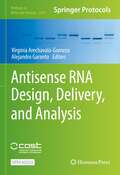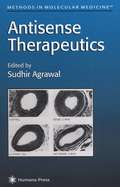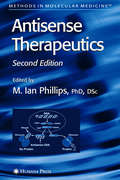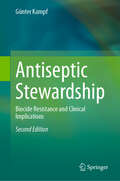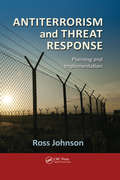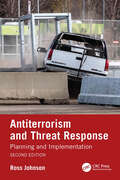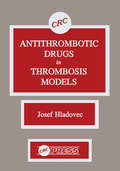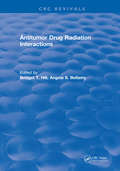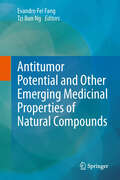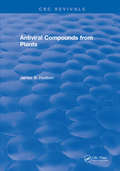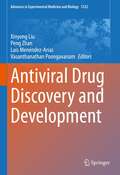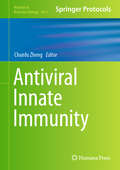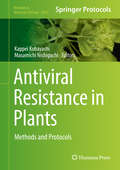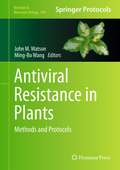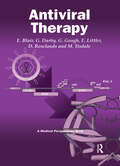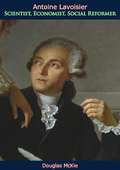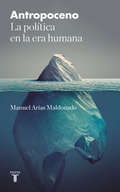- Table View
- List View
Antiplatelet Agents (Handbook of Experimental Pharmacology #210)
by Clive P. Page Gustav V. Born Paolo Gresele Carlo PatronoAntiplatelet therapy is the cornerstone of treatment of ischemic cardiovascular disease and over the last few years spectacular advancements in this field have been recorded. This is the first comprehensive handbook entirely dedicated to all the aspects of antiplatelet therapy. The book is divided into three main sections, pathophysiology, pharmacology and therapy, for a total of 23 chapters. A large group of leading experts from different European countries and from the USA, both from academia and industry, have contributed to the book. Besides a detailed overview on the pharmacology and clinical applications of all the currently used or of the novel antiplatelet agents, innovative approaches (e.g. intracellular signalling as an antiplatelet target, small RNAs as platelet therapeutics, etc.) or unconventional aspects (e.g. pharmacologic modulation of the inflammatory action of platelets are also treated. The book is oriented to both basic investigators and to clinicians involved with research on platelet inhibition or with the clinical use of antiplatelet therapies.
Antiprotozoal Drug Development and Delivery (Topics in Medicinal Chemistry #39)
by Claudiu T. Supuran Alane Beatriz VermelhoThis book reviews new promising drug targets for Neglected Tropical Diseases (NTDs), with a special focus on antiprotozoal drugs against trpyanosomatids Trypanosoma cruzi and Leishmania spp. The book offers a comprehensive overview of the most recent studied targets, and it outlines classical and new treatments and delivery strategies. Expert contributors describe new methods of analysis and bio-prospecting for new compounds, and provide a critical perspective of the translational process used in the research and development of new drug candidates. The book will appeal not only to researchers, students and professionals interested in drug development to protozoan diseases, but also to medicinal chemists in general.
Antipsychotic Trials in Schizophrenia
by T. Scott Stroup Jeffrey A. LiebermanAntipsychotic medications are a key treatment for schizophrenia, and sales of antipsychotic drugs approach $20 billion per year, with fierce marketing between the makers of the drugs.
Antisemitismus in der Klimabewegung: Zur Bedeutung und zum Diskurs um Antisemitismus in deutschen Klimagruppen (BestMasters)
by Kathrin RenzDer global erstarkende Antisemitismus und seit dem 07. Oktober 2023 insbesondere sein Ausdruck in antiisraelischer Agitation findet sich auch in linken und sich selbst als progressiv verstehenden Bewegungen. In diesem Buch wird untersucht, welche Antisemitismen sich in verschiedenen aktivistischen Gruppen der deutschen Klimabewegung finden lassen, welche Funktionsweisen sie erfüllen, weshalb sie attraktiv sind und auf welche Weise sie sich ausdrücken. Zudem betrachtet die Autorin, wie auftretender Antisemitismus in der Klimabewegung reflektiert und diskutiert wird und welche Positionen dabei von verschiedenen Akteur*innen eingenommen werden. Das Buch diskreditiert die Klimabewegung und ihre klimapolitischen Zielsetzungen dabei keineswegs in toto, aber zeigt Problemfelder und Muster notwendigerweise zu kritisierender Zustände auf.
Antisense Drug Technology: Principles, Strategies, and Applications, Second Edition
by Stanley T. CrookeExtensively revised and updated, Antisense Drug Technology: Principles, Strategies, and Applications, Second Edition reflects the logarithmic progress made in the past four years of oligonucleotide-based therapies, and, in particular, antisense therapeutics and research. Interpreting lessons learned from the clinical trials of first generati
Antisense RNA Design, Delivery, and Analysis (Methods in Molecular Biology #2434)
by Virginia Arechavala-Gomeza Alejandro GarantoThis open access volume gathers a variety of models, delivery systems, and approaches that can be used to assess RNA technology for exploiting antisense as a therapeutic intervention. Beginning with a section on the design of antisense technology and their delivery, the book continues by covering model systems developed to evaluate efficacy, both in vivo and in vitro, as well as methods to evaluate preclinically the toxicity associated with these new potential drugs, and intellectual property considerations. Written for the highly successful Methods in Molecular Biology series, chapters include introductions to their respective topics, lists of the necessary materials and reagents, step-by-step, readily reproducible laboratory protocols, and tips on troubleshooting and avoiding known pitfalls. Authoritative and practical, Antisense RNA Design, Delivery, and Analysis provides basic knowledge and a large collection of methods to facilitate the work of newcomers to this vibrant and expanding field. This book was conceived thanks to the network DARTER (Delivery of Antisense RNA Therapeutics). DARTER is funded by the EU Cooperation of Science and Technology (COST), which aims to enhance interaction and collaborations between researchers in Europe and other countries.
Antisense Therapeutics (Methods in Molecular Medicine #1)
by Sudhir AgrawalLeading researchers offer an authoritative survey and analysis of the latest findings on the rapid development of antisense oligonucleotides therapeutic and their application in various in vivo model systems. The book's high-profile contributors provide timely accounts of their state-of-the-art strategies, discussing such topics as the synthesis and purification of oligonucleotides, their selection for a particular gene target, different methods of administration, and the use of various cell lines and cell culture systems. They also examine questions of cellular uptake, in vitro biological activity, in vivo biological activity, the pharmacology and pharmacokinetics of oligonucleotides, and the application of oligonucleotides to the central nervous system.
Antisense Therapeutics (Methods in Molecular Medicine #106)
by M. Ian PhillipsA timely primer on the new reality of antisense and RNA inhibition for treating a broad range of diseases. The authors show how antisense oligonucleotides are being designed and studied in relation to hypertension, various cancers, inflammatory bowel disease, brain disorders, the blood-brain barrier, and drug delivery. Highlights include RNA-based therapies for many diseases, up-to-date methods and applications, and insight into the enormous potential to provide a new generation of drugs.
Antiseptic Stewardship: Biocide Resistance and Clinical Implications
by Günter KampfThis updated and expanded second edition of Antiseptic Stewardship serves as a comprehensive reference guide to common biocidal active substances and antiseptic agents, examining their antimicrobial efficacy and potential to induce cell tolerance, including cross-tolerance to other biocidal agents, as well as cross-resistance to antibiotics. In addition, the book discusses the appropriate and targeted use of biocidal active substances by balancing their expected health benefits against the likelihood of clinically relevant resistance, including misuse and overuse of some products during the COVID-19 pandemic. This guide, which focuses on human, veterinary and household products, helps readers make informed decisions about disinfectants and antiseptic products based on their composition. Various biocidal active substances and antiseptic agents are used for disinfection and antisepsis in healthcare, veterinary medicine, animal production and household products. However, not all of them provide significant health benefits, especially for some products used in human medicine. Antimicrobial soaps, surface disinfectants, instrument disinfectants and wound antiseptics may contain one or more biocidal active ingredients with comparable antimicrobial efficacy, but with large differences in their potential for microbial adaptation and tolerance. Increased bacterial tolerance has been described for several biocidal active substances and antiseptics, sometimes including cross-resistance to antibiotics. The book is therefore intended to help reduce unnecessary selection pressure on emerging pathogens, including by describing non-biocidal alternatives for specific antimicrobial applications, with the aim of retaining the powerful biocidal agents and antiseptics for those applications where there is a clear health benefit (e.g. reduction of healthcare-associated infections). The book addresses healthcare, industrial and veterinary professionals as well as educated laypersons interested in efficient and controlled disinfection strategies.
Antisocial
by Jillian BlakeWhat if your greatest secrets became public? For the students at Alexandria Prep, a series of hacks leads to a scandalous firestorm—and the students are left wondering whose private photos and messages will be exposed next. It’s Pretty Little Liars meets WikiLeaks.Senior spring at Alexandria Prep was supposed to be for sleeping through class and partying with friends. But for Anna Soler, it’s going to be a lonely road. She's just been dumped by her gorgeous basketball star boyfriend—with no explanation. Anna's closest friends, the real ones she abandoned while dating him, are ignoring her. The endearing boy she’s always had a complicated friendship with is almost too sympathetic. But suddenly Anna isn’t the only one whose life has been upended. Someone is determined to knock the kings and queens of the school off their thrones: one by one, their phones get hacked and their personal messages and photos are leaked. At first it's funny—people love watching the dirty private lives of those they envy become all too public. Then the hacks escalate. Dark secrets are exposed, and lives are shattered. Chaos erupts at school. As Anna tries to save those she cares about most and to protect her own secrets, she begins to understand the reality of our always-connected lives: Sometimes we share too much.
Antiterrorism and Threat Response: Planning and Implementation
by Ross JohnsonOne of the single greatest challenges to security professionals in the 21st century is terrorism. In the last several years, we have heard a lot about the importance of preparing for terrorist attacks. This book offers a way to prevent terrorist attacks. Providing security managers with a clear and simple methodology to protect their organizations,
Antiterrorism and Threat Response: Planning and Implementation
by Ross JohnsonAs security professionals, we tend to get seduced by the beauty of our technology. We go to trade exhibitions filled with the latest innovations and marvel at what we see without understanding how it fits in with what we do. It’s both overwhelming and distracting, like trying to learn to cook by walking through a grocery store.This focus on technology teaches us to judge the effectiveness of physical protection systems by the strength of the barriers, the acuity of the cameras, and the sensitivity of the sensors. Terrorists and criminals look for something else entirely, though: where we see strength, they find weakness and vulnerability. We are looking at the same things, but not seeing the same things. If we want to stop them, we need to know more than how they work. We need to learn to see the way they see.A physical protection system - that collection of people, sensors, barriers, policies, and technology – is a lot like a piano: and you cannot tell if a piano is in tune by looking at it. You have to play it. The major contribution of Antiterrorism and Threat Response: Planning and Implementation, 2e is the detailed instruction and practical advice on how to see the weaknesses and vulnerabilities in physical protection systems and upgrade them to meet the challenges of terrorists and criminals. Key features of this book are: Provides professionals with the background to understand how terrorists think and operate, in order to best coordinate their counterterrorism efforts and antiterrorism strategies Examines difficult new problems facing security professionals: such as the use of drones, guns, and the internet as a tool of both recruitment and indoctrination Teaches the reader how to step outside the security department to find and fix weaknesses and vulnerabilities in physical protection systems Introduces and discusses security management and insider threat risk management programs This is the advanced course in protecting physical assets from terrorists and criminals.
Antithrombotic Drugs in Thrombosis Models
by Josef HladovecAntithrombotic Drugs in Thrombosis Models presents a critical review of the use of thrombosis models and an original, highly sensitive methodology for testing antithrombotics based on a more adequate understanding of thrombotic processes. The methods form an integrated system stressing particularly the plurifactorial and global character of thrombosis and the key role of a generalized mild endothelial lesion. Packed with illustrations, this book documents the effectiveness of the system through the screening of a series of acknowledged and potential antithrombotics, and includes a unique study of their mutual combinations. Special emphasis is placed on the importance of biomodels for preliminary testing of antithrombotics. This book is particularly useful to researchers in pharmacology and the pharmaceutical industry; however, those interested in drug research and the field of cardiovascular medicine will benefit as well.
Antitumor Drug Radiation Interactions
by Bridget T. HillThis volume reviews the experimental data on drug-radiation interactions. Special emphasis is placed on clinically-useful antitumor drugs. Particular reference is made to appropriate timing, concentration and sequencing of drug-radiation combinations. It includes discussions on the relative merits of experimental data derived from animal versus human tumors. This book also presents a section on the potential for new model systems or alternative test procedures for evaluating therapeutic benefits and cytotoxicities. Results of randomized clinical studies are reviewed with emphasis on recent studies involving protocols specifically designed to test the benefits from optimal integration of chemotherapy with radiotherapy. This book is intended for laboratory researchers in the field and clinicians interested in using the combined modality approach. It is also a useful resource for radiologists, oncologists, and all those interested in cancer research.
Antitumor Potential and other Emerging Medicinal Properties of Natural Compounds
by Tzi Bun Ng Evandro Fei FangThe modern unhealthy diet and lifestyle in conjunction with pathogens, environmental carcinogens and multiple other risk factors increase humans' susceptibility to different diseases exemplified by elevated levels of cancers, cardiovascular and communicable diseases. Screening of potential drugs from medicinal plants and animals provides a promising strategy for the alleviation of the impact of these diseases. Components with potential medicinal applications include RIPs, RNases, lectins, protease inhibitors and numerous small compounds. These compounds have shown both preventive and therapeutic effects for humans. This book is a compilation of articles written by internationally renowned experts exploring the different uses of medicinal compounds in human therapeutics. Here we provide a comprehensive outlook on both qualitative and quantitative studies focusing on medicinal plants and animals, and establishing a link between laboratory research discovery and clinical applications.
Antiviral Compounds From Plants
by James B. HudsonThis timely publication describes the botanical sources and chemical features of antiviral compounds. It covers their mechanisms of action and evaluates their therapeutic potential. Included is a discussion of synthetic analogues where appropriate. The book states that antiviral compounds in so-called medicinal plants may constitute some of their "active ingredients." It explains that many are photosensitizers, their antiviral activity dependent upon or augmented by light of specific wavelengths. This book is of value to microbiologists, phytochemists, virologists, natural-product chemists, ethnobotanists, pharmacologists, medical and veterinary researchers, and others interested in the application of plant compounds to therapy of infectious diseases.
Antiviral Drug Discovery and Development (Advances in Experimental Medicine and Biology #1322)
by Xinyong Liu Peng Zhan Luis Menéndez-Arias Vasanthanathan PoongavanamThis book summarizes state-of-the-art antiviral drug design and discovery approaches starting from natural products to de novo design, and provides a timely update on recently approved antiviral drugs and compounds in advanced clinical development. Special attention is paid to viral infections with a high impact on the world population or highly relevant from the public health perspective (HIV, hepatitis C, influenza virus, etc.). In these chapters, limitations associated with adverse effects and emergence of drug resistance are discussed in detail. In addition to classical antiviral strategies, chapters will be dedicated to discuss the non-classical drug development strategies to block viral infection, for instance, allosteric inhibitors, covalent antiviral agents, or antiviral compounds targeting protein–protein interactions. Finally, current prospects for producing broad-spectrum antiviral inhibitors will be also addressed. The book is distinctive in providing the most recent update in the rapidly evolving field of antiviral therapeutics. Authoritative reviews are written by international scientists well known for their contributions in their topics of research, which makes this book suitable for researchers not only within the antiviral research community but also attractive to a broad audience in the drug discovery field. This book covers molecular structures and biochemical mechanisms mediating the antiviral effects, while discussing various ligand design strategies, which include traditional medicinal chemistry, computational chemistry, and chemical biology approaches. The book provides a comprehensive review of antiviral drug discovery and development approaches, particularly focusing on current innovations and future trends.
Antiviral Innate Immunity (Methods in Molecular Biology #2854)
by Chunfu ZhengThis detailed volume explores a variety of techniques for studying antiviral innate immunity and the type I interferon (IFN-I) signaling pathway. Beginning with guidelines to identify novel proteins from the host or viruses that regulate the antiviral IFN-I signaling pathway, the book continues with common and cutting-edge approaches for identifying novel regulatory factors, posttranslational modifications, as well as click chemistry to detect protein modifications. Other chapters delve into topics such as cytosolic RNA and DNA sensors, magnetic beads, cryo-electron microscopy, zebrafish, humanized mice, and organoids as model organisms to study host-virus interactions, and epidemiological approaches. Written for the highly successful Methods in Molecular Biology series, chapters include introductions to their respective topics, lists of the necessary materials and reagents, step-by-step and readily reproducible laboratory protocols, and tips on troubleshooting and avoiding known pitfalls. Authoritative and practical, Antiviral Innate Immunity serves as an ideal guide for researchers working in this vital area of the virology and innate immunity fields.
Antiviral Resistance in Plants: Methods and Protocols (Methods in Molecular Biology #2028)
by Kappei Kobayashi Masamichi NishiguchiThis detailed book explores strategies that have been developed to combat plant virus infection. Beginning with a section on techniques for identifying and studying the virus resistance gene involved in plant innate immunity, the volume continues by delving into techniques related to novel mechanisms of plant virus resistance, methods for the analysis and practical use of RNA silencing, as well as methods for the development of plant viral vaccines. Written for the highly successful Methods in Molecular Biology series, chapters include introductions to their respective topics, lists of the necessary materials and reagents, step-by-step, readily reproducible laboratory protocols, and tips on troubleshooting and avoiding known pitfalls. Authoritative and practical, Antiviral Resistance in Plants: Methods and Protocols serves as an ideal guide for researchers working to combat the serious threats plant virus diseases represent for agricultural production and beyond.
Antiviral Resistance in Plants: Methods and Protocols (Methods in Molecular Biology #894)
by John M. Watson Ming-Bo WangStudies related to pathogen-mediated virus resistance in plants were instrumental in providing some of the historical observations which ultimately led to the vital discovery of double-stranded RNA (dsRNA)-induced gene silencing or RNA interference (RNAi), which has since revolutionized research on plant-virus interactions. In Antiviral Resistance in Plants: Methods and Protocols, expert researchers in the field detail many of the methods which are now commonly used to study the phenomenon of RNA silencing in relation to viral infections of plants. These include methods and techniques for the isolation and quantitative/qualitative analyses of plant small 21-24 nucleotide RNAs such as small interfering RNAs (siRNAs) and microRNAs (miRNAs) as well as the analysis and manipulation of virus-induced gene silencing (VIGS) in both monocotyledonous and dicotyledenous plants and the use of hairpin RNA (hpRNA) transgenes. Written in the highly successful Methods in Molecular BiologyTM series format, chapters include introductions to their respective topics, lists of the necessary materials and reagents, step-by-step, readily reproducible laboratory protocols, and key tips on troubleshooting and avoiding known pitfalls. Authoritative and practical, Antiviral Resistance in Plants: Methods and Protocols seeks to aid scientists in the further study of this crucially important botanical trait.
Antiviral Therapy
by Dr Eddie Blair Dr Graham Darby Dr Gerlad Gough Dr Eddie Littler Prof D Rowlands Dr Margaret TisdaleA concise summary of vital information on drug targets and current therapy regimes for all of the major viral infections. The book brings together in a single volume aspects of antiviral therapy from diverse areas of research and practice, providing up-to-date coverage of recent developments. Starting from an overview of the history of antiviral chemotherapy, the book goes on to describe the development of drugs against HIV, herpesvirus, respiratory viruses, papillomaviruses and hepatitis virus infections. The drugs currently available are reviewed and possible therapies and drug targets for future prophylactic and therapeutic use are discussed.
Antoine Lavoisier: Scientist, Economist, Social Reformer (Series In Science)
by Douglas McKieANTOINE LAURENT LAVOISIER is heralded as the founder of modern chemistry whose genius was cut short by the brutal Revolutionary terror of the French Revolution. "Only a moment to chop off that head," said Lagrange the mathematician to Delambre, one of the inventors of the metric system, "and a hundred years may not give us another like it."Until Antoine Lavoisier, all matter was believed to be composed of four elements: earth, water, air and fire. It was Lavoisier who first showed that Nature was made out of much more complicated stuff, and that bodies burn not by releasing their fire element, but by combining with the element oxygen, the same element that enables plants and animals to breathe.
Antropoceno: La política en la era humana
by Manuel Arias MaldonadoEl Antropoceno es una nueva época geológica cuyo rasgo central es el protagonismo de la humanidad, convertida en agente de cambio medioambiental a escala planetaria. Desde una postura original, elegante y sensata, Arias Maldonado aprovecha todas las oportunidades que ofrece el concepto, un excelente marco teórico para el debate sobre la sostenibilidad global, la conservación de las formas y espacios naturales, así como para la moralización de las relaciones entre el ser humano y la naturaleza. La colonización humana del planeta ha terminado por conducirnos a una nueva época geológica: el Antropoceno. Al menos, así lo indica una sólida hipótesis científica según la cual el progresivo acoplamiento de los sistemas sociales y naturales ha hecho de la humanidad el principal agente de cambio medioambiental global. De manera que el Holoceno, bajo cuyas benévolas condiciones climáticas ha prosperado la humanidad, está dejando paso a un nuevo régimen planetario lleno de peligros y oportunidades. Del cambio climático a la extinción de especies, de la urbanización a la reforestación, el Antropoceno es un fenómeno ambiguo: un efecto colateral del progreso humano que despierta a las fuerzas telúricas que operan en el tiempo profundo y nos recuerda que somos criaturas terrenales. En este libro de vocación interdisciplinar, Manuel Arias Maldonado somete a riguroso análisis este novísimo concepto y se pregunta por sus consecuencias políticas. O sea: por los efectos que para la sociedad liberal y la democracia tiene una mutación planetaria que obliga a reorganizar las relaciones socionaturales.
Ants (Readers)
by Melissa StewartAnts are everywhere. They creep, they crawl, they climb, and they fall. But they get up and they keep on working. Ants come in all different shapes, different sizes, and different colors. And they do a lot of different jobs. These hard-working little creatures thrive wherever they go, making whatever adaptations necessary in their ever-changing world.National Geographic supports K-12 educators with ELA Common Core Resources.Visit www.natgeoed.org/commoncore for more information.
Ants Rule: The Long and Short of It
by Bob BarnerMite-size engineers construct the perfect roller coaster in this fun-filled introduction to measurement and data presentation.The ants need to plan the Blowout Bug Jamboree! But how can they build a roller coaster for the festival if they don't know how many bugs will come, or how big those bugs will be? This enjoyable introduction to measurement, comparison, and data visualization focuses on building math skills that aren't dependent on units-- so it works equally well for young readers used to inches or centimeters. And most of all-- it's fun! Colorful cut-paper art brings the bugs-- and their creations-- to life. In a deluxe fold-out spread, everything comes together in a huge, perfect rollercoaster-- big enough for all the bugs at the Jamboree to enjoy, and filled with tiny details for clever readers to spot!
